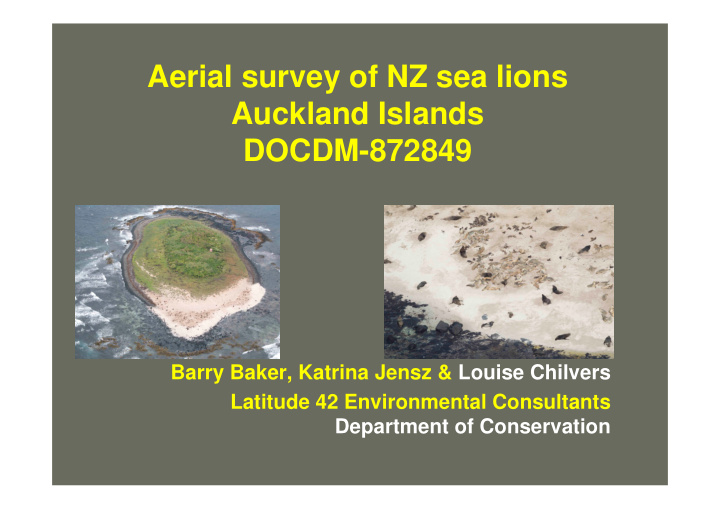



Aerial survey of NZ sea lions Auckland Islands DOCDM-872849 Barry Baker, Katrina Jensz & Louise Chilvers Latitude 42 Environmental Consultants Department of Conservation
background ─ only endemic NZ pinniped & world’s rarest sea lion ― 76% of pups born Auckland Islands at 4 sites Sandy Bay, Enderby Island South East Point, Enderby Island Dundas Island Figure or 8 Island 2
― sea lions have been monitored on Auckland Islands since early 1990s ― estimates derived from direct on-ground counts or use of M-R experiments ― considerable decline in pup production over last decade ― in January 2012 we undertook a study to trial alternative method to previous surveys - aerial photography 3
― work confined to 2 of the 4 Auckland Island breeding sites: 1. Sandy Bay, Enderby Island 2. Dundas Island ― other two sites either were unsuited to aerial photography (Figure of Eight Island) or contained few pups (South East Point) 4
methods • aerial platform Squirrel Helicopter • field work 11 – 15 January 2012 timed to occur at close to the time of ground & M-R counts • colonies documented using digital cameras • 2 groups of photos • overall scenic shots of colonies to assist later when building photomontages of sites • series of overlapping photos of all areas with pups (200 mm focal length) • close-up photos of puppy piles (500 mm lens) 5
methods • aerial platform Squirrel Helicopter • field work 11 – 15 January 2012 timed to occur at close to the time of ground & M-R counts • colonies documented using digital cameras • overall scenic shots of colonies to assist when building photomontages of sites • series of overlapping photos of all areas with pups (200 mm focal length) • close-up photos of puppy piles (500 mm lens) 6
methods • photos taken as raw or fine scale JPEG digital files of minimum 9 MB size • ideal flight height 1000 ft directly over colony • each colony photographed on 4 separate days to investigate temporal effects • All photography carried out between 0900 &1500 hours 7
counting protocols ― photomontages constructed using Adobe Photoshop software ― paintbrush tool mark off counted sea lions 8
data assessment ― all pups counted ― all images counted by one observer ― repeat counts of randomly selected montages by 2 other observers confirmed no evidence of observer bias in counting 9
NZSL age classes 10
11
ground counts ― direct counts carried out at Sandy Bay every day ― Mark-Recapture experiments: ― Sandy Bay 16 January 148 pups marked ― Dundas Island 21 January 380 pups marked ― results of each recapture were used to calculate a modified Petersen estimate ― dead pups added to estimates 12
results ― weather suitable for photography on 11, 12 & 14 January ― low cloud to sea level prohibitive to good photography on 13 January ― quality of photos taken generally excellent ― photos taken by both photographers on one day for one site photographic were consistently soft in focus ― not possible to determine life-status of pups 13
Sandy Bay comparative counts Area / Ground Aerial Lens Difference count count Date 11 Jan 337 358 200 mm -2 (-1%) 12 Jan 341 353 200 mm -7 (-2%) 14 Jan 340 293 200 mm -67 (-19%) 14 Jan 340 304 500 mm -56 (-16%) 16 Jan 361 14
Dundas Island comparative counts Area / Ground Aerial Lens Difference count count Date 11 Jan 1 269 200 mm 21 (2%) 12 Jan 1 207 200 mm -41 (-3%) 14 Jan 1 222 200 mm -26 (-2%) 21Jan 1 248 15
results ― In all but one case, the aerial counts underestimated the number of pups produced at both Sandy Bay and Dundas Island ― With the exception of one day, the aerial and mark-recapture counts were highly correlated and varied by less than 3%. ― For one day, 14 January, difference between aerial & ground count was 19%, or 16% if photos of puppy piles taken with 500 mm lens included in analysis 16
Sandy Bay – comparison of days 1 & 4 counts 17
discussion ― aerial photography appears to have great potential to provide robust, cost-effective estimates of NZSL pup production at the major pupping sites ― more work desirable to understand the disparity between Sandy Bay ground count and the one low aerial estimate, ― only plausible explanation is pups were missed because they were hidden deep in puppy piles 18
― to deal with this problem aerial counts may need to be undertaken on more than one day to achieve counts comparable with existing longitudinal dataset. Use maximum count obtained for this purpose ― pups & puppy piles are not static. Large piles that present counting difficulties one day likely to break up over a day or two ― dead pup issue needs further consideration ― future aerial surveys should be timed to occur as close as possible to the dates historically used for mark-recapture estimates 19
Acknowledgements Scientific &Technical Support: Ruth Sharples, John Barkla Helicopters Southern Lakes Helicopters & Chris Green Deepwater Group Richard Wells DOC: Pete McClelland, Sharon Trainor, Doug Veint, Igor Debski Ministry of Agriculture & Forestry: Martin Cryer, Aoife Martin Funding: DOC, MAFF, Deepwater Group 20
Recommend
More recommend